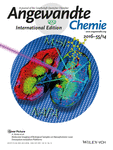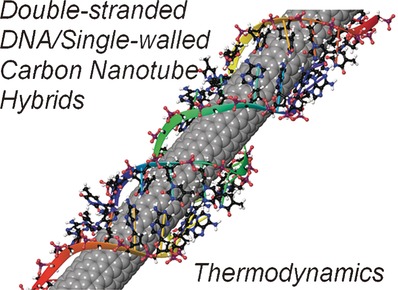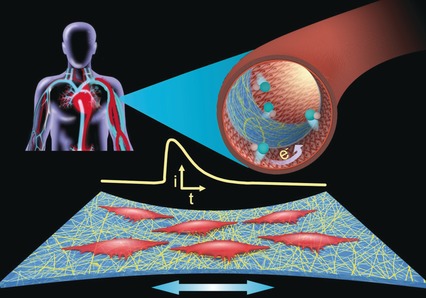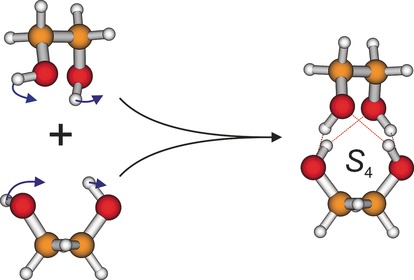Journal list menu
Export Citations
Download PDFs
Cover Pictures
Cover Picture: Molecular Imaging of Biological Samples on Nanophotonic Laser Desorption Ionization Platforms (Angew. Chem. Int. Ed. 14/2016)
- Page: 4369
- First Published: 11 March 2016
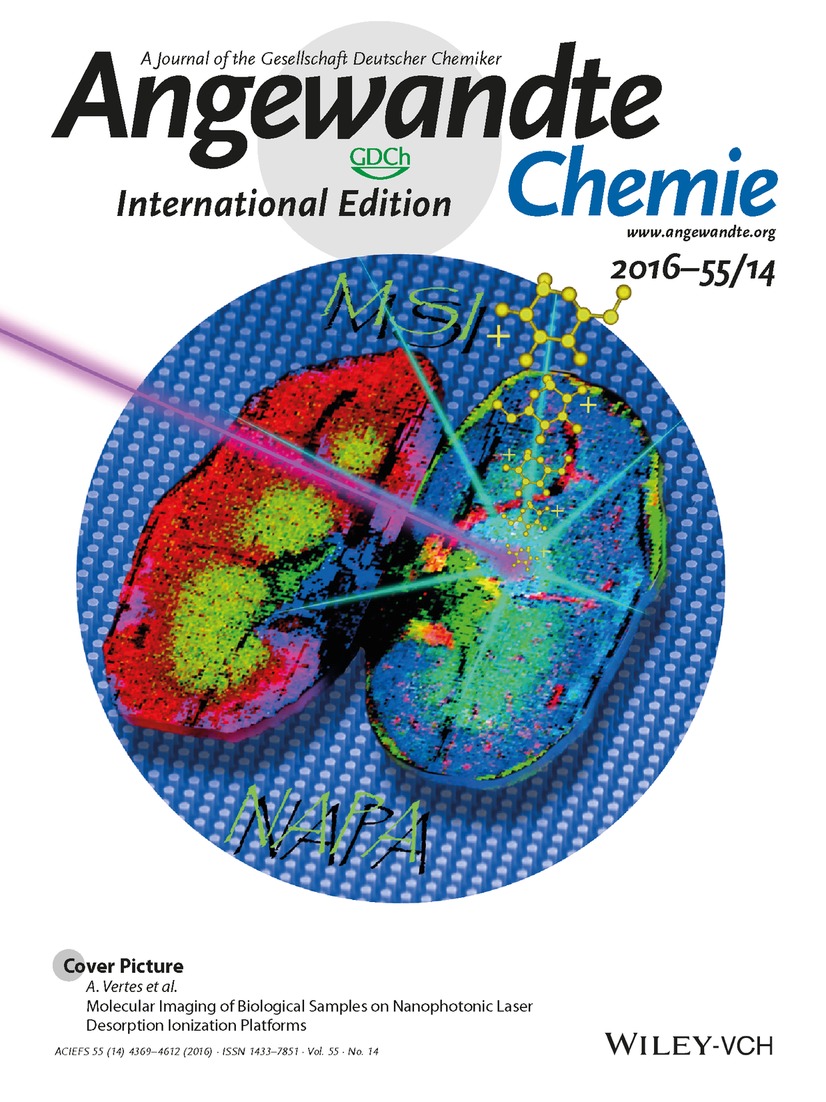
Molecular tissue imaging by mass spectrometry is achieved by using nanostructured substrates. In their Communication on page 4482 ff., A. Vertes and co-workers show how laser desorption ionization from silicon nanopost arrays (NAPA) unlocks the metabolite and lipid distributions in biological tissues. The picture shows the laser pulse interacting with a mouse kidney tissue section and the underlying nanostructure to produce ions for mass spectrometry imaging (MSI).
Inside Cover: Esterase-Sensitive Prodrugs with Tunable Release Rates and Direct Generation of Hydrogen Sulfide (Angew. Chem. Int. Ed. 14/2016)
- Page: 4370
- First Published: 08 March 2016
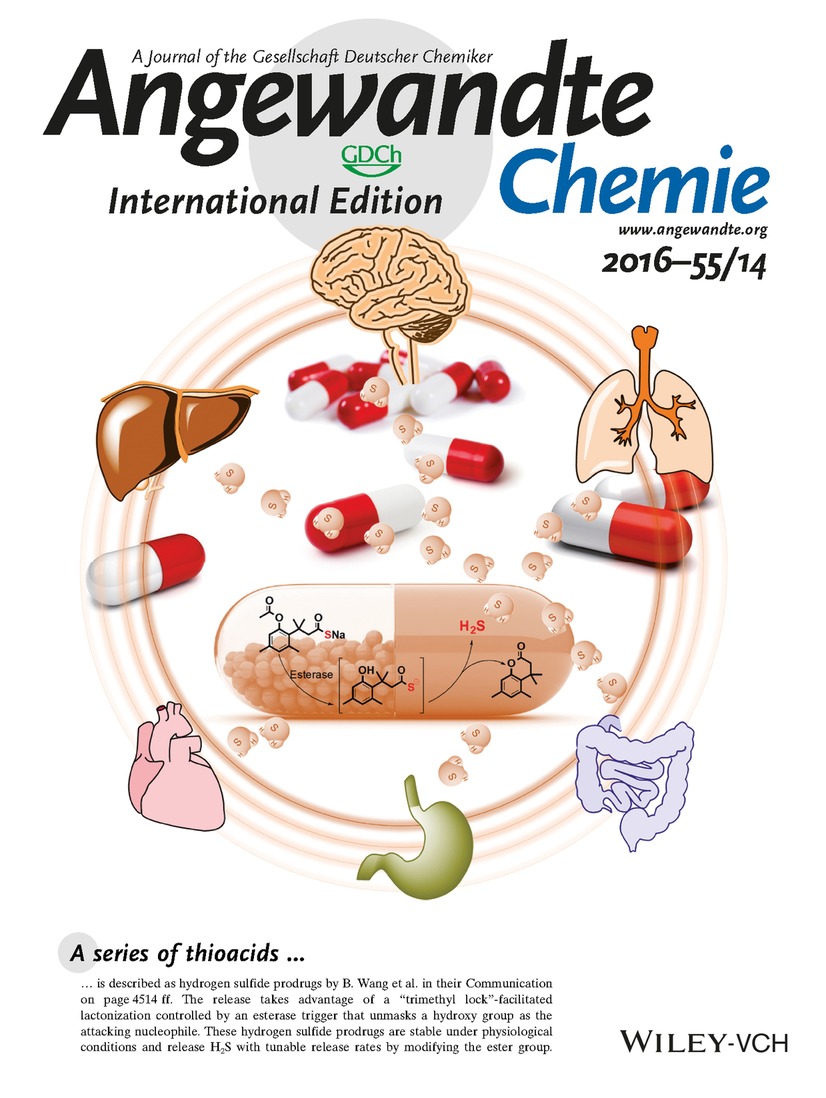
A series of thioacids is described as hydrogen sulfide prodrugs by B. Wang et al. in their Communication on page 4514 ff. The release takes advantage of a “trimethyl lock”-facilitated lactonization controlled by an esterase trigger that unmasks a hydroxy group as the attacking nucleophile. These hydrogen sulfide prodrugs are stable under physiological conditions and release H2S with tunable release rates by modifying the ester group.
Inside Back Cover: l-Arginine-Triggered Self-Assembly of CeO2 Nanosheaths on Palladium Nanoparticles in Water (Angew. Chem. Int. Ed. 14/2016)
- Page: 4611
- First Published: 11 March 2016
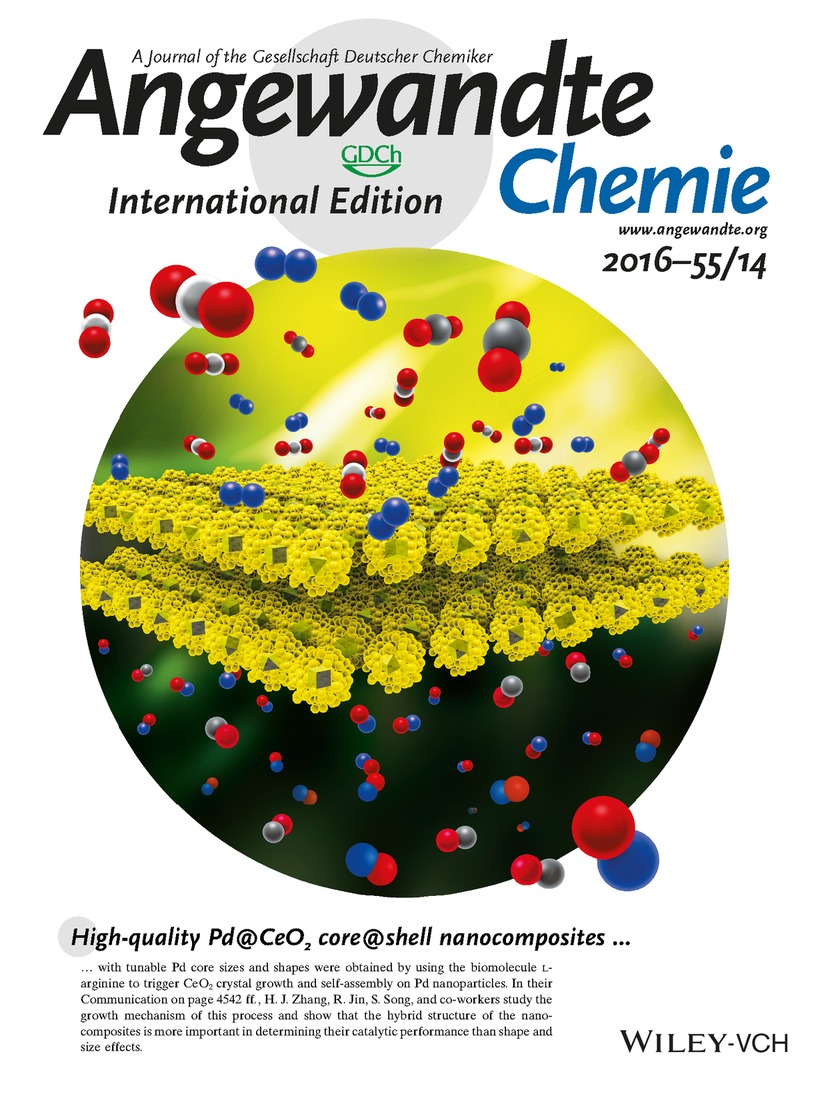
High-quality Pd@CeO2 core@shell nanocomposites with tunable Pd core sizes and shapes were obtained by using the biomolecule l-arginine to trigger CeO2 crystal growth and self-assembly on Pd nanoparticles. In their Communication on page 4542 ff., H. J. Zhang, R. Jin, S. Song, and co-workers study the growth mechanism of this process and show that the hybrid structure of the nanocomposites is more important in determining their catalytic performance than shape and size effects.
Back Cover: Biodegradable Inorganic Nanovector: Passive versus Active Tumor Targeting in siRNA Transportation (Angew. Chem. Int. Ed. 14/2016)
- Page: 4612
- First Published: 08 March 2016
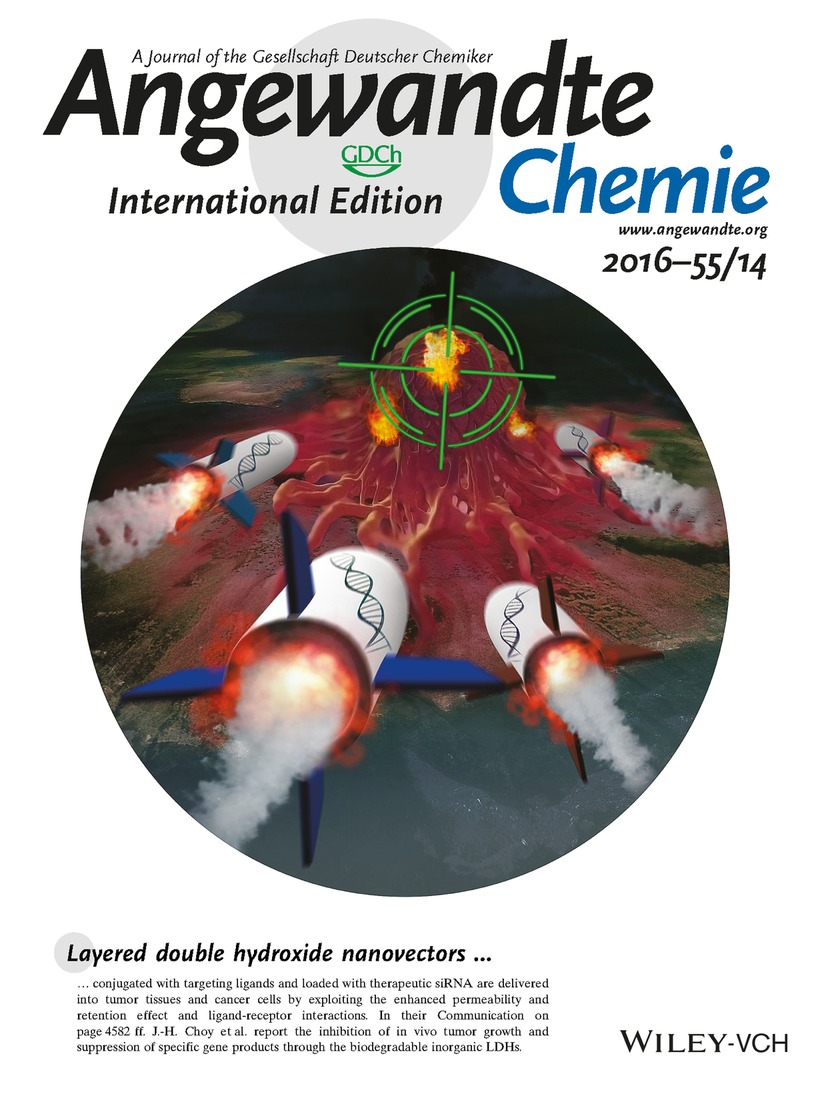
Layered double hydroxide nanovectors conjugated with targeting ligands and loaded with therapeutic siRNA are delivered into tumor tissues and cancer cells by exploiting the enhanced permeability and retention effect and ligand-receptor interactions. In their Communication on page 4582 ff. J.-H. Choy et al. report the inhibition of in vivo tumor growth and suppression of specific gene products through the biodegradable inorganic LDHs.
Frontispiece
Frontispiece: Total Syntheses of the Tetracyclic Cyclopiane Diterpenes Conidiogenone, Conidiogenol, and Conidiogenone B
- First Published: 21 March 2016
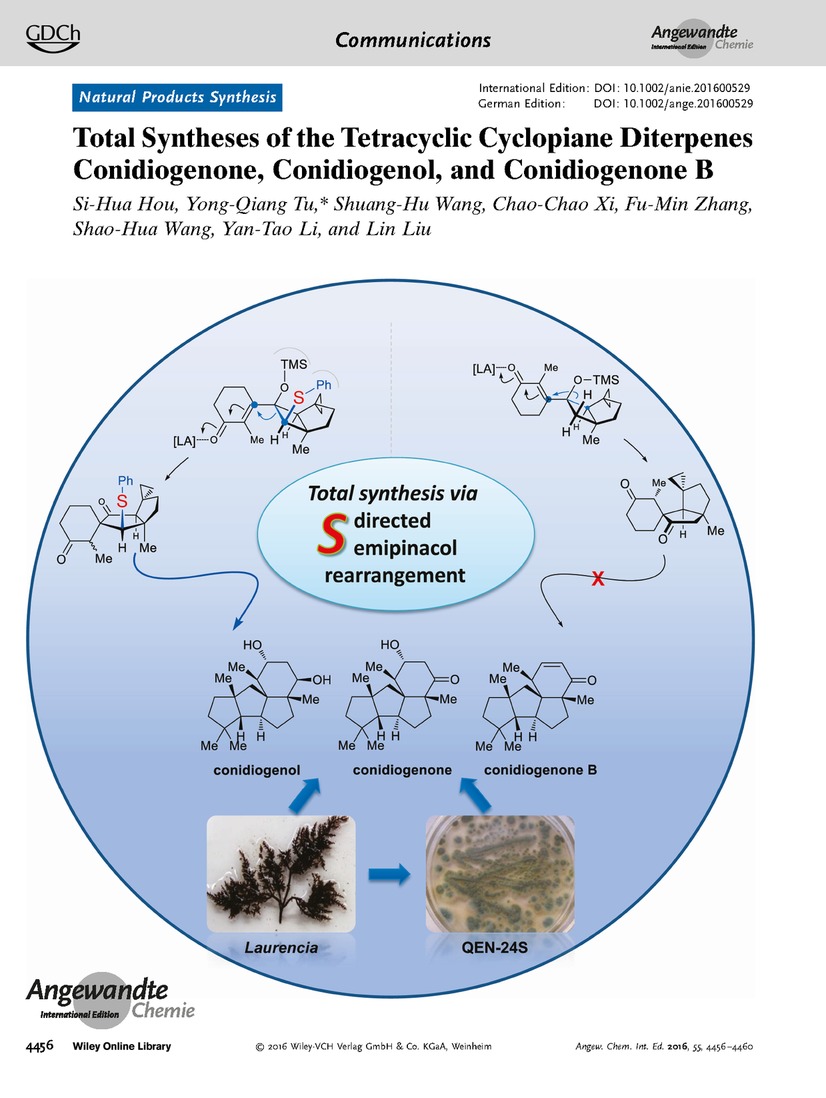
Total Synthesis. By installing a SPh “directing” group on the expected migratory carbon of the precursor, Y.-Q. Tu and co-workers in their Communication on page 4456 ff. perform the first total synthesis of cyclopiane class tetracyclic diterpenes.
Editorials
Biocatalysis: Successfully Crossing Boundaries
- Pages: 4372-4373
- First Published: 04 December 2015

“ … The creation of robust biocatalysts with desired properties was previously challenging. Nowadays, knowledge of bioinformatics, protein engineering, molecular biology, high-throughput screening, as well as experience in biocatalysis and organic synthesis, are key skills to identify, develop, and implement novel synthetic routes …” Read more in the Editorial by Uwe T. Bornscheuer.
Graphical Abstract
Graphical Abstract: Angew. Chem. Int. Ed. 14/2016
- Pages: 4375-4384
- First Published: 21 March 2016
News
Spotlights on our sister journals: Angew. Chem. Int. Ed. 14/2016
- Pages: 4388-4391
- First Published: 21 March 2016
Author Profiles
News
Royal Australian Chemical Institute Awards: C. Yu, J. G. Shapter, and C. J. Jackson / Wilhelm Manchot Research Professorship: M. G. Kanatzidis
- Page: 4393
- First Published: 17 February 2016
Reviews
Synthetic Methods
Stereoselective Halogenation in Natural Product Synthesis
- Pages: 4396-4434
- First Published: 02 February 2016
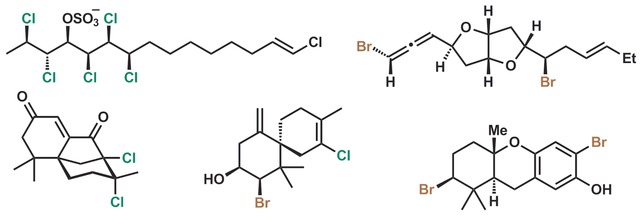
With thousands of natural products containing halogen-bearing stereogenic centers, a wealth of methods have been developed for their stereocontrolled introduction in the context of total synthesis. This Review highlights the creative ways in which organic chemists have dealt with the challenges of stereochemically rich, halogenated natural products.
Hypervalent Iodine Compounds
Cyclic Hypervalent Iodine Reagents for Atom-Transfer Reactions: Beyond Trifluoromethylation
- Pages: 4436-4454
- First Published: 16 February 2016
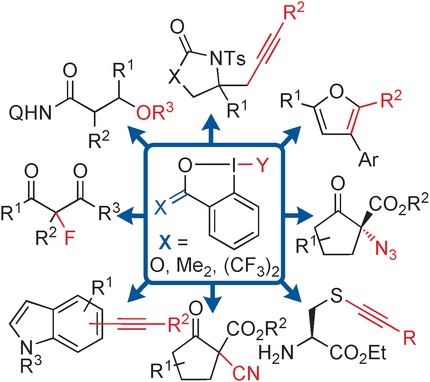
The exceptional reactivity of hypervalent iodine compounds make them privileged reagents in organic synthesis. Of them, cyclic derivatives stand apart because of their enhanced stability. The use of benziodoxol(on)es for trifluoromethylation (Togni's reagents) is now well recognized, but other transformations have also attracted strong interest recently. The progress in the area since 2011 is presented in this Review. Q=8-aminoquinoline.
Communications
Natural Products Synthesis
Total Syntheses of the Tetracyclic Cyclopiane Diterpenes Conidiogenone, Conidiogenol, and Conidiogenone B
- Pages: 4456-4460
- First Published: 03 March 2016

Three of a kind: The biologically important tetracyclic diterpenes conidiogenone, conidiogenol, and conidiogenone B (see scheme) were constructed by an efficient strategy involving an intramolecular [2+2] cyclization, a regio- and diastereoselective semipinacol rearrangement, and an intramolecular aldol cyclization as key steps. The synthesis also enabled the correction of the absolute configuration of naturally occurring conidiogenone B.
Nanomaterials
Use of Three-Dimensional Arterial Models To Predict the In Vivo Behavior of Nanoparticles for Drug Delivery
- Pages: 4461-4466
- First Published: 01 March 2016
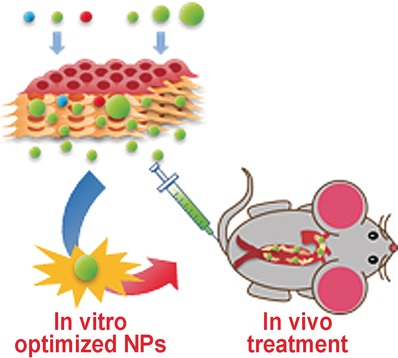
Throw away the crystal ball: Three-dimensional human-artery models allowed in vitro prediction of the in vivo behavior of drug-delivery nanoparticles. In vivo experiments with atherosclerotic mice suggested strong biological characteristics and potential treatment effects of nanoparticles optimized in vitro (see picture). This approach is a promising alternative to animal experiments for the optimization of nanomaterials.
Antiferromagnetic Materials
β-Ag3RuO4, a Ruthenate(V) Featuring Spin Tetramers on a Two-Dimensional Trigonal Lattice
- Pages: 4467-4471
- First Published: 04 March 2016

Magnetic attraction: β-Ag3RuO4 was synthesized using hydrothermal conditions. The crystal structure is based on a hexagonal close packing of oxygen, and displays tetrameric polyoxoanions [Ru4O16]12− embedded in a 2D trigonal environment. The Ru4 diamonds are separated by silver, which suppress the frustrated antiferromagnetic exchange common to trigonal lattices. Strong interanionic antiferromagnetic interactions dominate instead. Key: Ag gray, Ru cyan, O red.
Drug Discovery
In-Bead Screening of Hydroxamic Acids for the Identification of HDAC Inhibitors
- Pages: 4472-4475
- First Published: 04 March 2016
Porous Capsules
The Uptake and Assembly of Alkanes within a Porous Nanocapsule in Water: New Information about Hydrophobic Confinement
- Pages: 4476-4481
- First Published: 16 February 2016
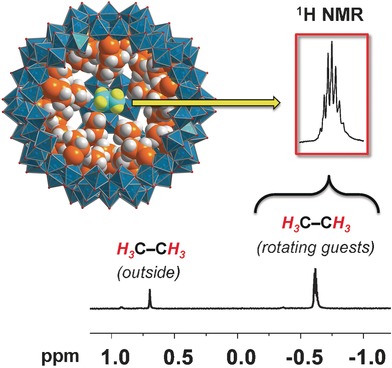
In the porous metal oxide capsule [{MoVI6O21(H2O)6}12{(MoV2O4)30(L)29 (H2O)2}]41− (L=propionate), the ethyl tails of the endohedrally coordinated ligands form a spherical, hydrophobic shell, while their methyl end groups generate a hydrophobic cavity at the center of the capsule. Whereas C7 to C3 alkanes are tightly intercalated between the ethyl tails, two or three rapidly rotating ethane molecules reside in the central cavity.
Mass Spectrometry Imaging
Molecular Imaging of Biological Samples on Nanophotonic Laser Desorption Ionization Platforms
- Pages: 4482-4486
- First Published: 01 March 2016

Weight and see: A matrix-free mass spectrometry imaging technique uses nanophotonic ionization based on laser desorption ionization from a highly uniform silicon nanopost array. In mouse-brain and kidney tissue sections, the distributions of over 80 molecular species could be determined with 40 μm spatial resolution.
Wearable Devices | Hot Paper
High-Performance Lithium–Air Battery with a Coaxial-Fiber Architecture
- Pages: 4487-4491
- First Published: 01 March 2016

Bendy batteries: A flexible, fiber-shaped lithium–air battery was developed from a gel polymer electrolyte and an aligned carbon nanotube sheet air electrode. It delivered a high specific capacity of 12 470 mAh g−1 and could work for 100 cycles in air. Its electrochemical performance was maintained during and after bending and it could be woven into textiles to power electronic devices.
Reaction Mechanisms
Double Deprotonation of Pyridinols Generates Potent Organic Electron-Donor Initiators for Haloarene–Arene Coupling
- Pages: 4492-4496
- First Published: 03 March 2016
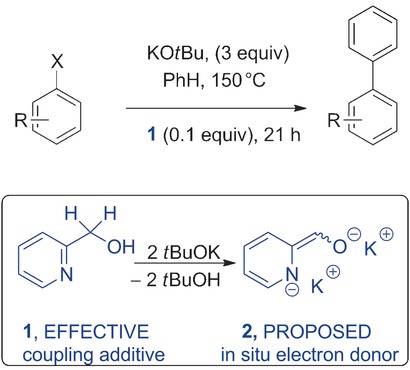
Trigger happy: Transition-metal-free couplings of iodoarenes with arenes are triggered by the use of alkali metal alkoxides in the presence of an organic additive. Recently 1 was shown to extend the reaction to aryl bromides. Evidence is reported for the dianion (2), derived from 1, which serves as an electron donor to initiate the reaction. Routes by which electron-poor benzoyl derivatives can be transformed into electron donors to initiate these reactions are also proposed.
Membrane Proteins
Reconstitution of the Cytb5–CytP450 Complex in Nanodiscs for Structural Studies using NMR Spectroscopy
- Pages: 4497-4499
- First Published: 29 February 2016
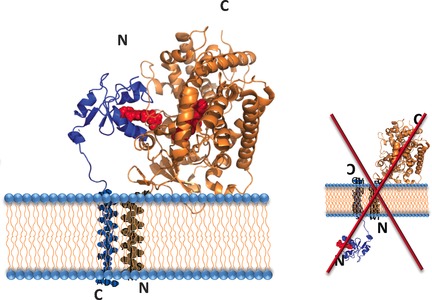
Stay on the right side: Co-reconstitution of the cytP450–cytb5 complex into a lipid membrane environment is achieved using peptide-based nanodiscs containing a planar lipid bilayer, completely obviating the need to use denaturing detergents. NMR experiments revealed effective interactions between the two proteins to form productive complexes where the proteins are properly oriented with respect to each other and to the lipid bilayer.
High-Throughput Screening
Combinatorial Low-Volume Synthesis of Well-Defined Polymers by Enzyme Degassing
- Pages: 4500-4503
- First Published: 03 March 2016
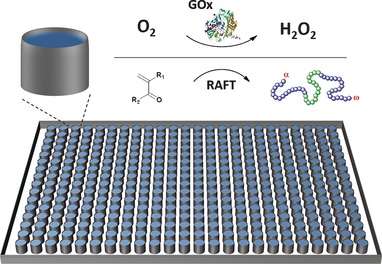
Micro-RAFTing: By using the enzyme glucose oxidase to effectively remove oxygen, highly controlled polymers are prepared in low volumes under ambient conditions on 384 well plates. This method enables the combinatorial synthesis of polymer libraries for high-throughput screening applications. RAFT=reversible addition–fragmentation chain transfer.
Anion Recognition | Hot Paper
Anion Recognition and Induced Self-Assembly of an α,γ-Cyclic Peptide To Form Spherical Clusters
- Pages: 4504-4508
- First Published: 04 March 2016
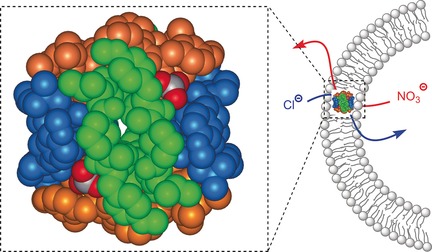
A cyclic octapeptide has been shown to fold into a “V-shaped” conformation that allows the selective recognition of anions such as chloride, nitrate, and carbonate. The selective anion recognition process involves the simultaneous assembly of six cyclic peptide subunits and four anions to give a supramolecular cluster that efficiently facilitates transmembrane transport of the anions.
Colloid Interfaces
Synthesis of Monodisperse Bi-Compartmentalized Amphiphilic Janus Microparticles for Tailored Assembly at the Oil–Water Interface
- Pages: 4509-4513
- First Published: 01 March 2016

Colloidal anisotropies: Bicompartmentalized Janus microparticles were synthesized using seeded polymerization. Selectively patching the silica nanoparticles onto one of the bulb surfaces allowed the Janus particles to assemble at the oil–water interface with a designated level of adhesion, thus producing structurally stable Pickering emulsions.
H2S Release
Esterase-Sensitive Prodrugs with Tunable Release Rates and Direct Generation of Hydrogen Sulfide
- Pages: 4514-4518
- First Published: 28 January 2016

Tunable H2S supply: Prodrugs that release hydrogen sulfide upon esterase-mediated cleavage of an ester group followed by lactonization are described (see example). By modifying the ester group and thus its susceptibility to esterase H2S release rates can be tuned. The anti-inflammatory effects of one candidate were examined by studying its ability to inhibit TNF-α production in RAW 264.7 cells.
Macrocycles | Very Important Paper
Peptide [4]Catenane by Folding and Assembly
- Pages: 4519-4522
- First Published: 03 March 2016
![Peptide [4]Catenane by Folding and Assembly](/cms/asset/b90ce1a0-a9a5-4bb7-a315-59172cccdbe1/anie201600480-toc-0001-m.jpg)
It's all about topology: Upon complexation with silver(I) the tripeptide ligand (Pro-Gly-Pro) simultaneously folds into an Ω-looped conformation and self-assembles into a discrete peptide [4]catenane with the crossing number of 12. Within the [4]catenane each of the four equivalent M3L3 macrocycles is interlocked with the other three rings with tetrahedral symmetry.
CO2 Adsorption | Hot Paper
Selective CO2 Adsorption in a Supramolecular Organic Framework
- Pages: 4523-4526
- First Published: 01 March 2016
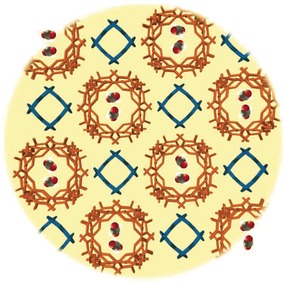
SOFly, SOFly: Two supramolecular organic frameworks (SOFs) based on C-pentylpyrogallol[4]arene (PgC5) with spacer molecules, such as 4,4′-bipyridine, are prepared. Their highly optimized and symmetric intermolecular hydrogen-bonding interactions give robust extended frameworks. One of the evacuated frameworks shows excellent affinity for carbon dioxide over other gases.
Asymmetric Catalysis
Highly Enantioselective Rhodium-Catalyzed Addition of Arylboroxines to Simple Aryl Ketones: Efficient Synthesis of Escitalopram
- Pages: 4527-4531
- First Published: 02 March 2016

Wing it: The title reaction has been achieved for the first time with a Rh/(R,R,R,R)-WingPhos catalyst, providing a range of chiral diaryl alkyl carbinols with excellent ee values and yields. The method was applied for a concise synthesis of the antidepressant drug escitalopram. MTBE=tert-butyl methyl ether.
Magnetic Clusters
Magnetic Properties of a Single-Molecule Lanthanide–Transition-Metal Compound Containing 52 Gadolinium and 56 Nickel Atoms
- Pages: 4532-4536
- First Published: 29 February 2016
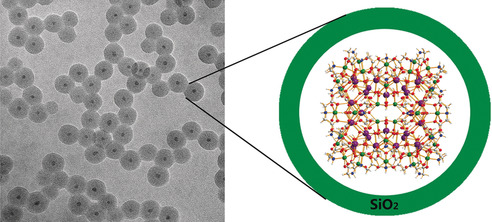
Molecular magnet: A single-molecule metal compound of 1 a encapsulated in a silica nanosphere (1 a=[Gd52Ni56(IDA)48(OH)154(H2O)38]18+) was prepared through a facile one-pot microemulsion method (see picture). The single-molecule high-nuclearity lanthanide–transition-metal compound showed experimentally and theoretically magnetic interactions.
Biosensors | Hot Paper
Stretchable Electrochemical Sensor for Real-Time Monitoring of Cells and Tissues
- Pages: 4537-4541
- First Published: 01 March 2016
Core–Shell Nanoparticles
l-Arginine-Triggered Self-Assembly of CeO2 Nanosheaths on Palladium Nanoparticles in Water
- Pages: 4542-4546
- First Published: 07 March 2016
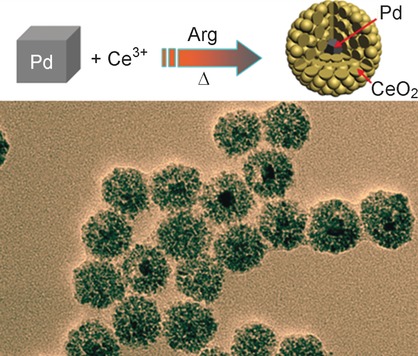
Strictly structured: The biomolecule l-arginine triggered CeO2 crystal growth and self-assembly on Pd nanoparticles. Following the initial formation of cerium–l-arginine precursors on the Pd surface, heat treatment led to the production of high-quality Pd/CeO2 nanostructures (see picture). By controlling the synthetic conditions, it was possible to tune the core size and shape, nanostructure, and sheath thickness of the resulting nanospheres.
Heterocyclic Synthesis
Harnessing the Electrophilicity of Keteniminium Ions: A Simple and Straightforward Entry to Tetrahydropyridines and Piperidines from Ynamides
- Pages: 4547-4551
- First Published: 02 March 2016

Powerful electrophiles: properly substituted keteniminium ions, simply generated by acidic treatment of the corresponding ynamides, can induce a remarkably efficient [1,5]-hydride shift from unactivated C−H bonds. This triggers a cationic cyclization which gives, within minutes, highly functionalized tetrahydropyridine and piperidine derivatives.
Heterocycles
Catalytic and Enantioselective Synthesis of Chiral Multisubstituted Tribenzothiepins by Intermolecular Cycloadditions
- Pages: 4552-4556
- First Published: 02 March 2016

End of the tether: The first catalytic and highly enantioselective synthesis of tribenzothiepin derivatives was achieved. Two types of intermolecular cycloadditions, either using diphenyl-sulfide-tethered diynes or 2-phenyl sulfanylbenzene tethered diynes with a monoalkyne, led to chiral multisubstituted tribenzothiepins in good to excellent ee values under mild reaction conditions. The present protocol was used to prepare a chiral tribenzoselenepin.
Synthetic Methods
Rhodium-Catalyzed Synthesis of 4-Bromo-1,2-dihydroisoquinolines: Access to Bromonium Ylides by the Intramolecular Reaction of a Benzyl Bromide and an α-Imino Carbene
- Pages: 4557-4561
- First Published: 02 March 2016

Illustrious ylides: 4-Bromo-1,2-dihydroisoquinolines were obtained conveniently from 4-(2-(bromomethyl)phenyl)-1-sulfonyl-1,2,3-triazoles 1 through the formation of bromonium ylides from α-imino rhodium carbene intermediates and subsequent rearrangement (see scheme). The versatile products participated as intermediates in a series of one-pot reactions and were converted into valuable polycyclic systems.
Reduction
Chemoselective Reduction of Tertiary Amides under Thermal Control: Formation of either Aldehydes or Amines
- Pages: 4562-4566
- First Published: 02 March 2016
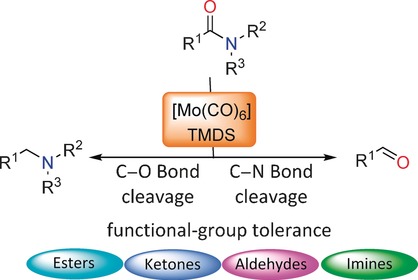
The choice is yours: [Mo(CO)6] is demonstrated to be an efficient catalyst for the chemoselective reduction of tertiary amides in the presence of a large number of reducible groups, including imines and aldehydes. The reaction is tunable by variation of the temperature, and either an amine or an aldehyde can be obtained as the major product from the corresponding amide. TMDS=1,1,3,3-tetramethyldisiloxane.
Cross-Coupling
Synthesis of Aryldifluoroamides by Copper-Catalyzed Cross-Coupling
- Pages: 4567-4572
- First Published: 01 March 2016

Double the eFFect: A copper-catalyzed coupling of aryl, heteroaryl, and vinyl iodides with α-silyldifluoroamides is reported. The reaction forms α,α-difluoro-α-aryl amides from electron-rich, electron-poor, and sterically hindered aryl iodides in high yield and tolerates a variety of functional groups. The aryldifluoroamide products can be further transformed to provide access to a diverse array of difluoroalkylarenes. TMS=trimethylsilyl.
Palladium Catalysis
α-Arylation of Ketimines with Aryl Sulfides at a Low Palladium Catalyst Loading
- Pages: 4573-4576
- First Published: 01 March 2016

Aryl sulfides, although typically poisonous to transition-metal catalysts, serve as aryl electrophiles in the catalytic α-arylation of ketimines. Low catalyst loadings (down to 0.5 mol %) of a Pd–NHC complex are sufficient for efficient arylation. α-Arylated ketimine products were used to synthesize various azaarenes including 2,3-diarylpyrroles.
Light Harvesting | Very Important Paper
Flexible Near-Infrared Photovoltaic Devices Based on Plasmonic Hot-Electron Injection into Silicon Nanowire Arrays
- Pages: 4577-4581
- First Published: 01 March 2016

Flexible friend: The quantum efficiency of flexible photovoltaic devices in the near-infrared spectral region has been improved by integrating Si nanowire arrays with plasmonic Ag nanoplates. The Ag nanoplates can directly harvest and convert NIR light into plasmonic hot electrons for injection into Si, while the Si nanowire arrays allow light trapping. The flexible devices show excellent durability over 50 flexing cycles.
Drug Delivery | Hot Paper
Biodegradable Inorganic Nanovector: Passive versus Active Tumor Targeting in siRNA Transportation
- Pages: 4582-4586
- First Published: 16 February 2016
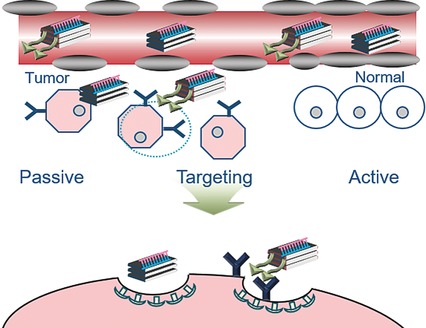
Cancer therapy: An inorganic layered double hydroxide (LDH) nanovector with a folic acid (FA) conjugated surface showed siRNA-based cancer therapeutic efficacy in vivo through receptor-mediated active targeting (see picture). A 1.2-fold higher accumulation of the drug was achieved in tumor tissue, resulting in 3.0-fold higher suppression of tumor volume.
Cross-Coupling
Enantioconvergent Fukuyama Cross-Coupling of Racemic Benzylic Organozinc Reagents
- Pages: 4587-4590
- First Published: 04 March 2016

Converging on a moving target: The first enantioconvergent palladium-catalyzed Fukuyama cross-coupling of racemic benzylic organozinc reagents with thioesters has been developed. The reaction furnishes acyclic α,α-disubstituted ketone products in good yields and high enantioselectivities, under mild reaction conditions which prevent racemization of the potentially labile tertiary stereocenter.
Vibrational Spectroscopy
A Symmetric Recognition Motif between Vicinal Diols: The Fourfold Grip in Ethylene Glycol Dimer
- Pages: 4591-4595
- First Published: 01 March 2016
Bis(carboranes) | Very Important Paper
Carborane Substituents Promote Direct Electrophilic Insertion over Reduction–Metalation Reactions
- Pages: 4596-4599
- First Published: 02 March 2016
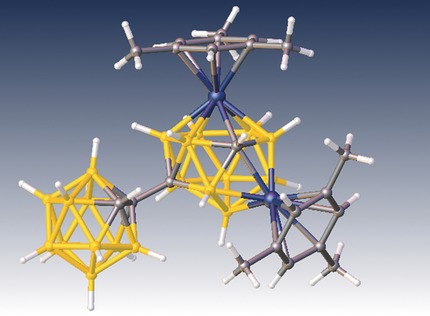
Take two: Two-electron reduction of 1,1′-bis(o-carborane) and subsequent metalation with {Ru(mes)}2+ results in a 4,1,8-RuC2B10 species. A further two-electron reduction allows a direct electrophilic insertion reaction promoted by the carborane substituent for the addition of a second metal fragment and the formation of 1,13,2,9-Ru2C2B10. A mechanism is proposed to rationalize the observed fluxionality of the products.
Heterocycles
Exploiting Distal Reactivity of Coumarins: A Rhodium-Catalyzed Vinylogous Asymmetric Ring-Opening Reaction
- Pages: 4600-4604
- First Published: 04 March 2016

Gamma style: While γ-functionalization is well established in the setting of aldol, Mannich, and Michael reactions, γ-reactivity is scarce in other reaction classes. By using the newly developed vinylogous reactivity involving the release of ring strain in the rhodium-catalyzed asymmetric ring opening (ARO) the privileged coumarin motif was incorporated into the hydronaphthalene scaffold enantioselectively.
Synthetic Methods
Photooxygenation of Furylalkylamines: Easy Access to Pyrrolizidine and Indolizidine Scaffolds
- Pages: 4605-4609
- First Published: 02 March 2016
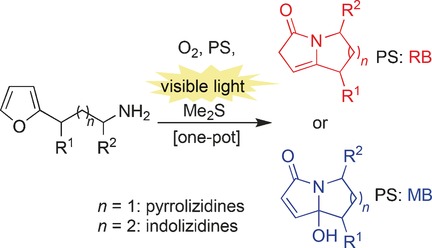
Singlet oxygen is able to transform unprotected primary furylalkylamines into the important pyrrolizidine and indolizidine scaffolds. The outcome of the one-pot sequences can be readily tailored to need by varying the choice of sensitizer. The synthetic utility of this method was demonstrated in the rapid synthesis of five natural products. PS: Photosensitizer. RB: rose Bengal. MB: Methylene blue.




